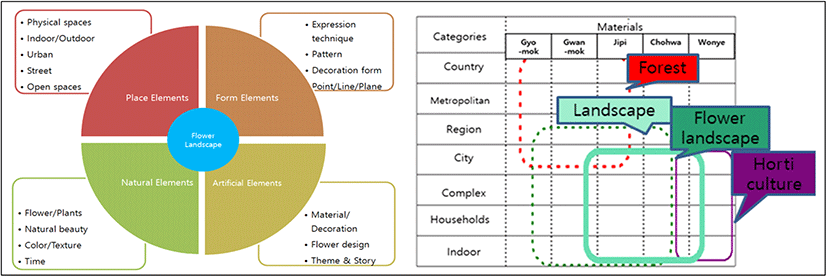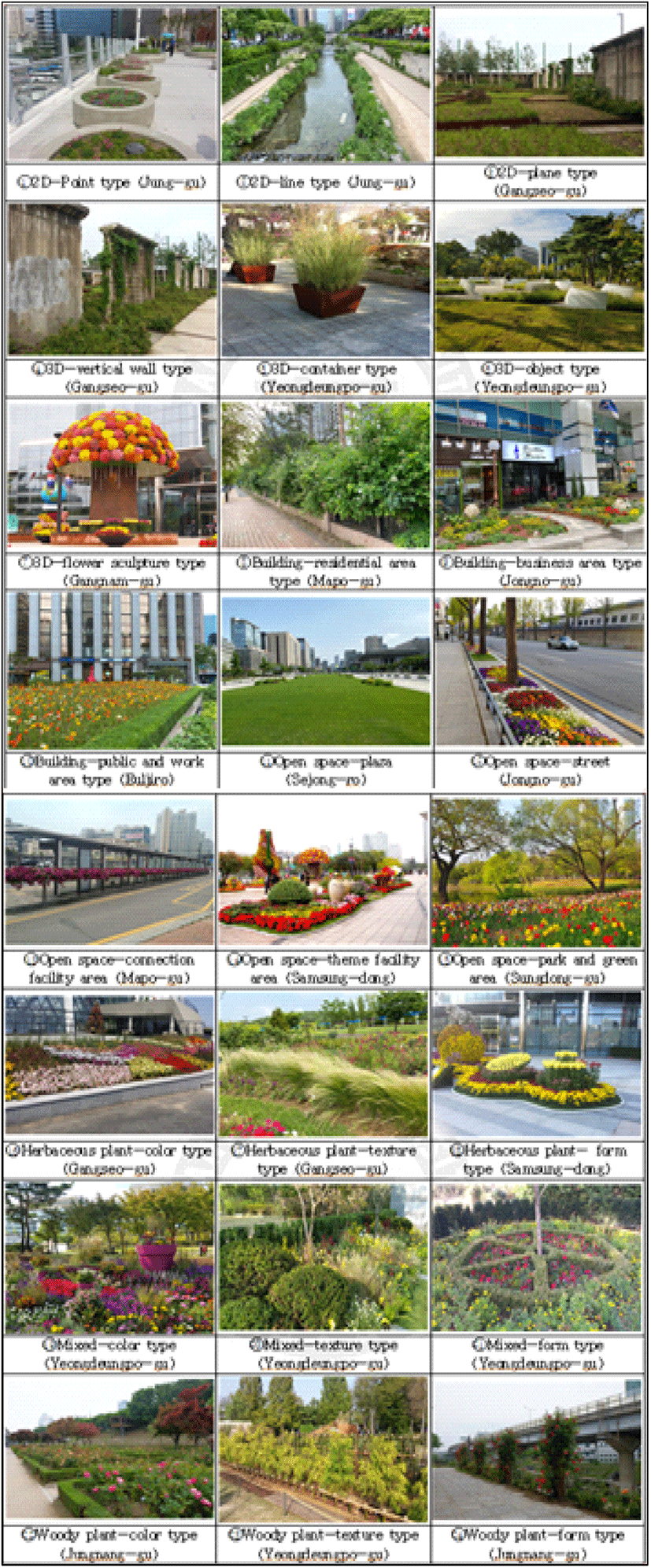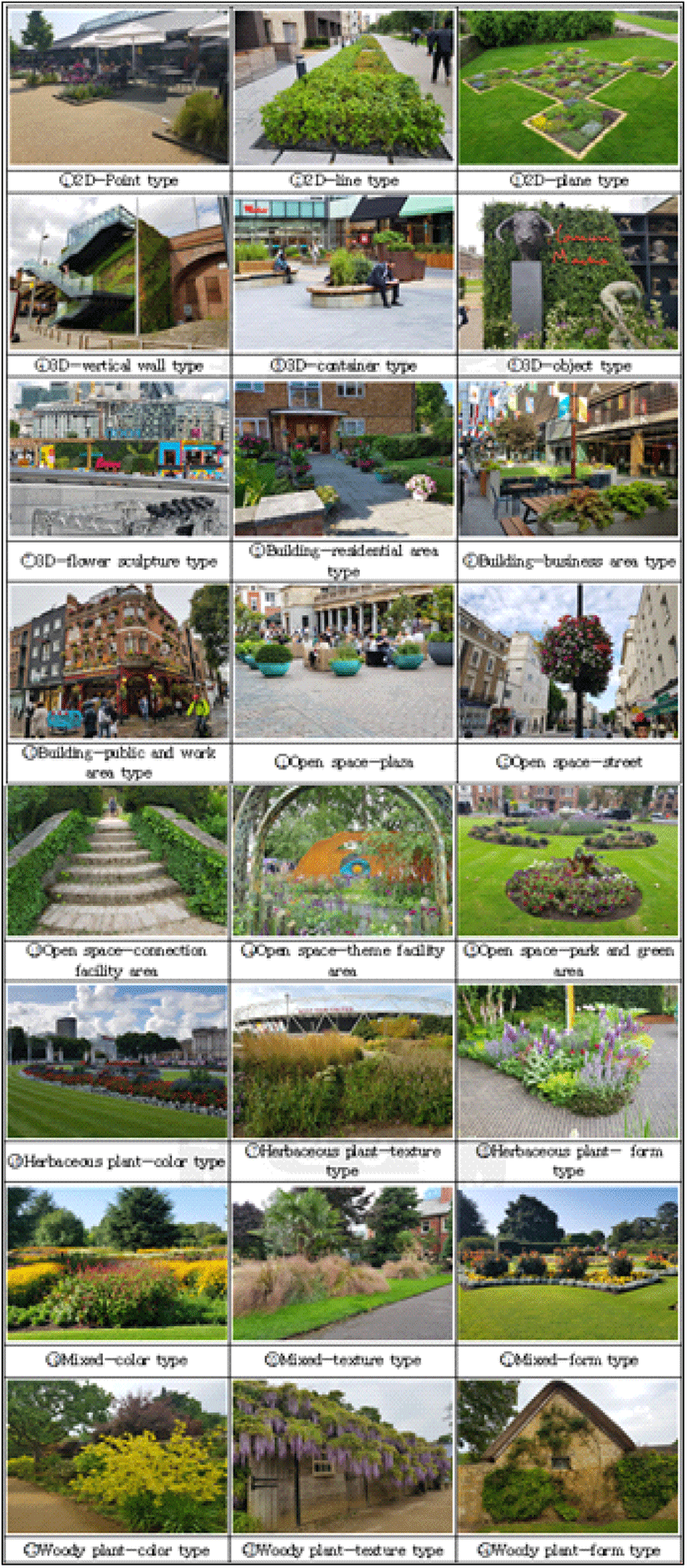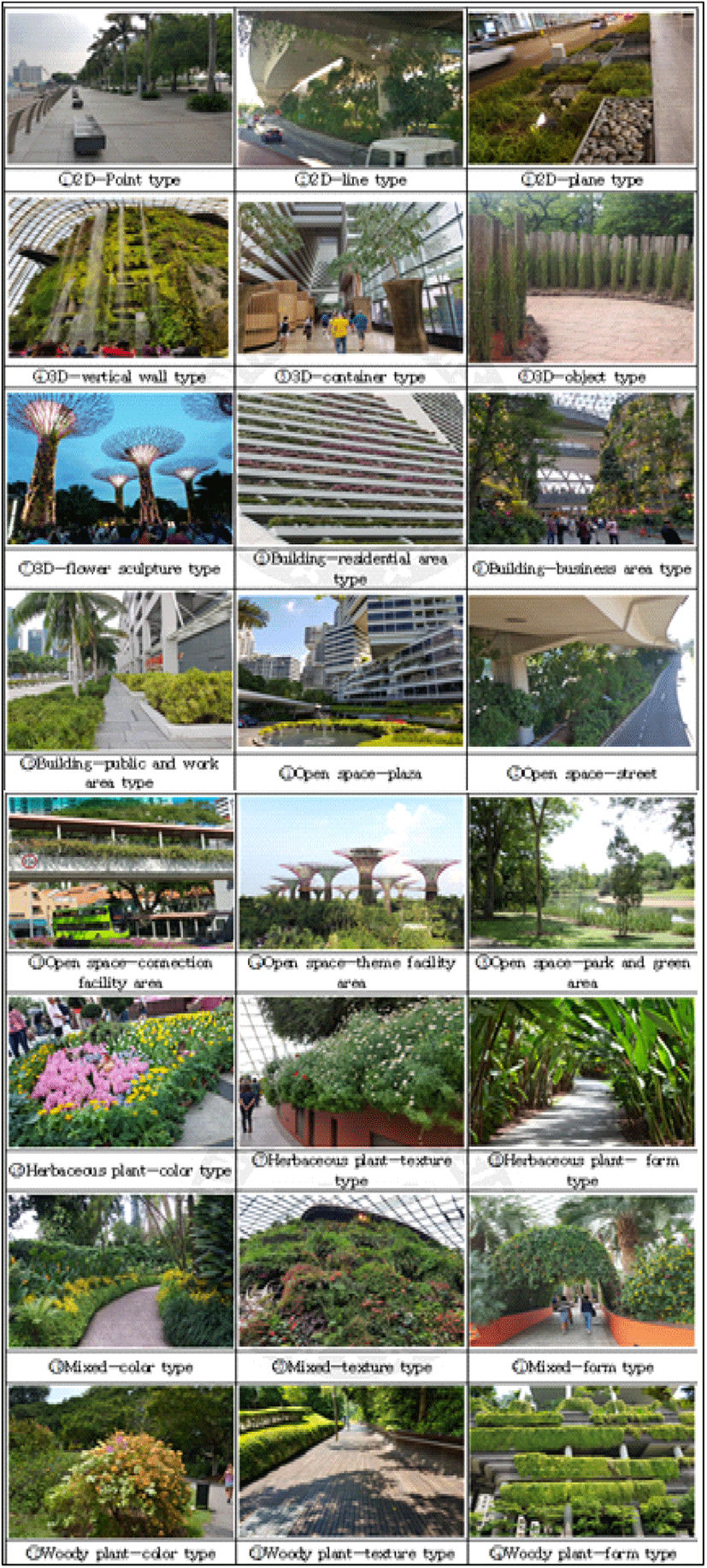Ⅰ. 서론
현재 화훼 산업은 그 규모면에서 1조 원을 상회하는 시장이형성되어 있을 만큼 시장 크기가 커지고 광범위한 분야에서 다양하게 이용되고 있다. 소득 수준이 높은 유럽 선진국 사례에서 보듯, 경관적 가치재로서의 도시 화훼는 소득과 밀접한 관계가 있으며, 우리나라도 인당 국민소득 3만 달러 시대, 쾌적한 도시환경의 중요한 요소라고 볼 수 있다. 즉, 현재는 시기적으로 도시경관의 외연 확대와 소재 개발이 중요한 시점으로서 도시 화훼에 대한 체계적인 유형 분류가 중요하다. 그러한 환경에도 불구하고 화훼와 관련된 기존의 연구들은 개념의 정의도 국지적이고 협소할 뿐만 아니라, 화훼경관의 도시경관성을 규명하는 측면에서 한계를 지니고 있다. 이런 현상하에서 본 연구의 배경은 첫째, 도시경관으로서 화훼경관의 시대적 역할이 증대되고 있고, 둘째, 화훼경관 관련 이론의 부족, 셋째, 화훼경관 유형화 정립의 필요성 대두이다. 또한, 본 연구는 다양하게 존재하는 화훼경관의 양상들을 타당한 기준에 의해 분류하는 유형화 작업과 그 과정을 통해 유형의 체계를 구축하고자 한다. 따라서, 본 연구의 목적은 이와 같은 배경을 바탕으로 첫째, 화훼경관이 도시경관의 한 장르로 그리고 도시경관의 단위로 왜 정의되고 연구할 필요가 있는지를 밝혀 전문영역으로서 체계 구축, 둘째, 도시 화훼경관 유형화를 통한 화훼경관 통합 이론의 기초자료를 제공하기 위함이다.
Ⅱ. Ⅱ. 이론 고찰
화훼경관에 대한 개념은 화훼분야에서 불리는 여러 개념과 도시경관 분야에서 통칭되는 여러 개념 사이에서 많은 용어들을 동원하고 조합하여 가장 적합한 개념을 가공하고 만들어 정리하는 과정이 필요하다. Kang(2001)은 ‘주된 소재를 꽃으로 하여 때와 장소, 또는 목적에 따라서 생각이나 표현하고 싶은 것들을 점, 선, 면, 공간, 색, 재질, 운동감 등의 요소를 조합하여 하나의 미적인 형태를 구성하는 것이며 여기에는 디자이너가 가지고 있는 사상과 미적 감각이 반영된다’고 하였고, Son (2004)은 ‘화훼장식물이란 관상 화훼식물을 주 소재로 한 인간의 창의력과 표현 능력을 활용하여 공간의 기능과 미적 효율성을 높여주는 장식물을 제작하거나 설치 및 유지 관리하는 기술’이라고 정의하였다.
화훼경관의 개념은 첫째, Yoon(2006) 문헌을 참조하여 연구자가 재정리한 화훼사를 통해 본 화훼경관 유사개념 11가지,둘째, 화훼분야에서 학술적 정리과정 없이 일반 사용용어로 통용되는 유사개념 12가지, 셋째, 선행 연구논문에서 화훼경관 관련 유사개념이 언급된 12편의 자료를 참고하였다. 선행연구 고찰을 통해 본 화훼경관 관련 유사개념의 초기는 공간적 범위에서 실내 중심이었던 것이 옥외를 향하게 되고, 공간의 개념이 확장되면서 옥외 환경에 필요한 새로운 개념들이 생겨난다. 선행연구를 통해 도출한 화훼경관의 개념을 결정하는 핵심 4요소는 공간적 요소, 형태적 요소, 자연적 요소, 인공적 요소이다(Figure 1 참조).
선행연구 분석을 통해 도출된 화훼경관의 핵심 4요소를 기반으로 화훼경관 개념을 정리하면 ‘도시 화훼경관이란 도시(공간적 요소)에 도입된 경관의 주요 재료인 화훼(자연적 요소)의 활용 범위를 도시적 스케일로 확장해서 바라보는 관점으로 인간이 정주하는 도시 공간에서 꽃과 식물(자연적 요소)이라는 주재료의 속성을 도시경관의 구성요소인 건축물, 오픈스페이스(인공적 요소) 등과 조화롭도록 인간이 창의력을 발휘(인공적 요소)하여 미적 효율성과 생태적 순환체계가 작동되도록 만들어진 화훼기반의 의도된 전망이나 경치(형태적 요소)라고 개념화할 수 있다’ 이를 요약하여 정리하면, “도시 화훼경관이란 경관재로서 도입된 화훼의 활용 범위를 도시적 스케일에서 바라보는 관점으로 인간이 정주하는 도시 공간에서 꽃과 식물이라는 주재료가 지니고 있는 속성 즉, 심미성, 생태성 인자가 도시 구성요소와 결합하여 도시 공간의 미적 효율성과 생태적 도시기능이 작동되도록 만들어진 화훼기반의 의도된 전망이나 경치”를 말한다.
Yoon(2016)는 ‘인류 역사속에서 인간과 식물은 불가분성을 가져왔으며, 식물이 기본적으로 가지고 있는 본성을 인간이 도시환경에 맞추는 과정에서 부분적 조작에 의해 재탄생한 것이 화훼장식이다. 또, 화훼장식물은 꽃이나 꽃과 직접 관련된 것, 또는 그 이미지가 주체가 되지만 인간의 창조적 활동이 그 속에 담겼을 때 비로소 작품으로 아름답게 표현된다’라고 하였다. 이는 화훼경관과 도시민의 밀접한 관계의 설명이다(Figure 2 참조). 도시경관으로서 화훼경관의 역할과 비중은 첫째, 화훼경관은 도시민의 감성을 자극하고 밝은 도시를 유지하며, 삶을 쾌적하게 하는 중요한 도시환경의 요소이다. 둘째, 화훼경관은 인간의 다양한 활동이 이루어지는 도시에서 도시의 개성과 특성을 빠르고 이미지화하는 효과 연출이 즉각적으로 가능하다. 셋째, 도시는 끊임없이 변화한다는 속성을 가지고 있는데, 이런 다양한 사회 구성원들의 생각과 문화, 시시각각 변하는 생활 트랜드가 화훼의 속성인 시간의 유한함, 자연성과 흡사하다. 넷째, 화훼경관은 도시 공간에 대한 이미지를 상승시키고, 살아 있는 식물이 주는 자연미와 화려함, 생동감을 느끼게 해주어 회색의 도시를 녹색의 자연 친화적인 분위기를 유도한다.
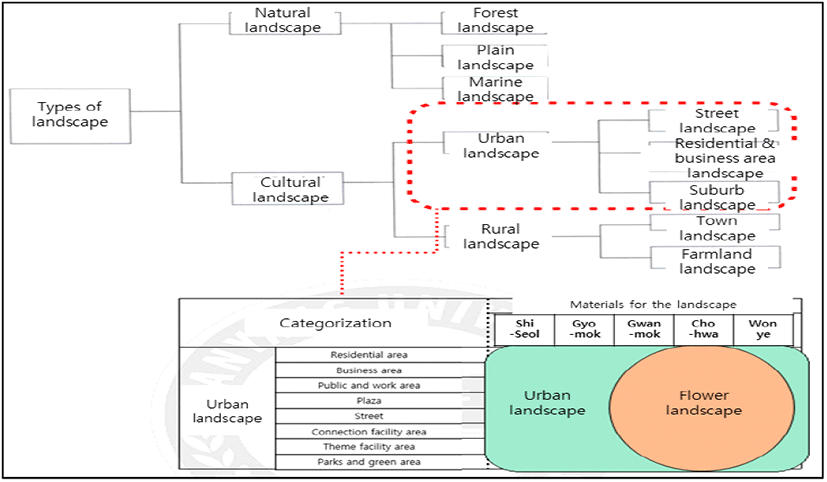
기존 연구의 한계점으로 화훼경관 개념에 관한 연구는 화훼 관련 선행 연구의 대다수가 실내 화훼장식물로서 공간 배치 특성이 실내로 한정되고, 실외 도시경관적 차원의 규정과 개념은 미흡하다. 실외와는 다소 차이가 있는 실내 중심의 개념이 일부 활용될 수밖에 없었고, 또 화훼경관 개념을 도출하는 과정에서 학술적 개념 정리가 안 된 시중에서 통용되는 용어들을 추려서 연구자가 정리하였지만, 그 개념들을 그대로 채택할 수 없어 Figure 1에서처럼 문헌과 일반통용 용어 분석을 통해 추출된 핵심 4요소를 기반으로 연구자가 새롭게 개념을 재구성하였다. 불가피하지만 이 과정에서 연구자의 관점이 다소 관여된 한계를 갖는다. 실내 화훼장식 중심의 연구가 대부분을 차지한 가운데 실외 연구는 최근에 정원 붐과 관련하여 정원에 대한 경향, 특성, 유형을 분석하는 보고나 연구가 많아지고 있는 것은 분명해 보인다. Jung(2016)에 의하면 ‘사회적 인식변화뿐 아니라 정책적으로 ‘수목원 정원의 조성 및 진흥에 관한 법률’ 개정을 계기로 정원문화 확산과 정원산업활성화 논의와 한국조경학회의 정원연구센터 설립, 한국정원디자인학회 활동 등이 전반적인 정원 관련 연구의 활발함의 예시’라고 하였다. 다만, 정원과 화훼경관은 범위와 대상, 개념이 다르다. 정원이 화훼경관의 한 유형이라고 보았을 때 정원보다 상위 단위라고 볼 수 있는 도시적 스케일의 화훼경관이 아직 개념과 체계를 뚜렷하게 못 갖추고 있다는 측면은 화훼경관의 전문영역화 과정에 한계를 갖고 있다는 것을 나타낸다. 이에 본 연구에서는 기존 선행연구와의 차별화를 다음과 같이 가져가고자 한다. 화훼경관이 도시경관의 한 장르로, 그리고 도시경관의 단위로 왜 정의하고 연구할 필요가 있는지, 시계열적 분석을 통한 도시 화훼경관의 개념을 제시하고 도시경관성을 규명한다, 그리고 선행연구와 사례조사를 통해 도시 화훼경관 유형화 작업을 전문가 FGI를 통해 진행하면서 유형의 타당성 확보와 수요자들에게 합리적이고 효율적인 화훼경관 유형의 선택자료를 제시한다는 측면에서 기존 연구들과의 차별성이 있다.
Ⅲ. 분석의 틀
사례조사를 통한 대상지는 서울과 인구 규모나 면적이 유사한 대도시들을 기준으로 하였다. 인구가 1,000만에 이르는 서울을 도시문제와 도시 복잡성에서 그에 버금가는 규모의 대도시와 비교함으로써 경관 전략 또는 화훼경관 방식에 대한 모티브와 시사점을 찾을 수 있지 않을까 판단하였다. ①인구 규모는 500만 이상, ②그린인프라는 인당 공원면적 10m2 이상, ③유동인구는 연간 외국인 관광객 1,000만 명 이상, ④화훼경관 연출의 국내 적용성 등을 기준으로 하였다(Figure 1 참조).
첫째, 인구 500만 기준은 고밀화 도시로서 도시 특성을 충분히 담아내고 있기 위해서이고 파리가 요건을 충족시키지 못했다. 둘째, 인당 공원면적 10m2 이상은 공간별, 형태별, 재료별 화훼경관의 사례가 일반화된 도시의 요건으로 보았으며 도쿄가 4.5m2로 여건을 충족하지 못했다. 셋째, 유동인구 외국인 관광객 연간 1,000만 명 이상으로 하였고, 관광도시이자 거점 도시로서 유동인구가 많아 정원, 식물, 꽃을 도시 이미지로 적극 활용하는 매개 변수의 척도로 판단하였으며 베이징이 요건을 충족하지 못하였다. 넷째, 연출 적용성은 화훼경관의 국내 적용 정도나 활동가들의 국내 유입 정도 등을 종합적으로 고려하였다. 최종 대상지는 서울, 싱가포르, 런던이다(Table 1 참조).
도시 화훼경관의 유형화 요소 도출을 위해 같은 맥락에 있는 기존의 선행연구를 살펴보고, 도시 화훼경관 유형화의 분류 근거가 될 수 있는 구성요소를 도출하였다. 그리고 산림청, 국토교통부, 각 지자체에서 제공하는 경관 관련 지침을 비롯하여 광역시도별 경관계획, 정원 및 산림 계획 관련 가이드라인 및 연구보고서를 수집하여 도시 화훼경관 유형화 구성요소 도출에 활용하였다. 국내 및 해외 사례와 관련해서는 도시와 관련된 설명자료, 사진자료, 현지답사 등을 통해 자료를 수집하였다(Table 5 참조).
본 연구에서는 선행연구 및 사례 연구를 통해 도출된 화훼경관 유형화 분류의 기준이 되는 요소들 중 유사 요소군별로 군집화하고 이 요소들의 재분류와 재분류된 요소를 기준으로 유형화 과정을 밟는 방식으로 진행하였고, 타당성을 확보하기 위해 전문가들의 경험을 통한 의견을 수렴하고자 FGI를 실시하였다(Figure 3 참조).
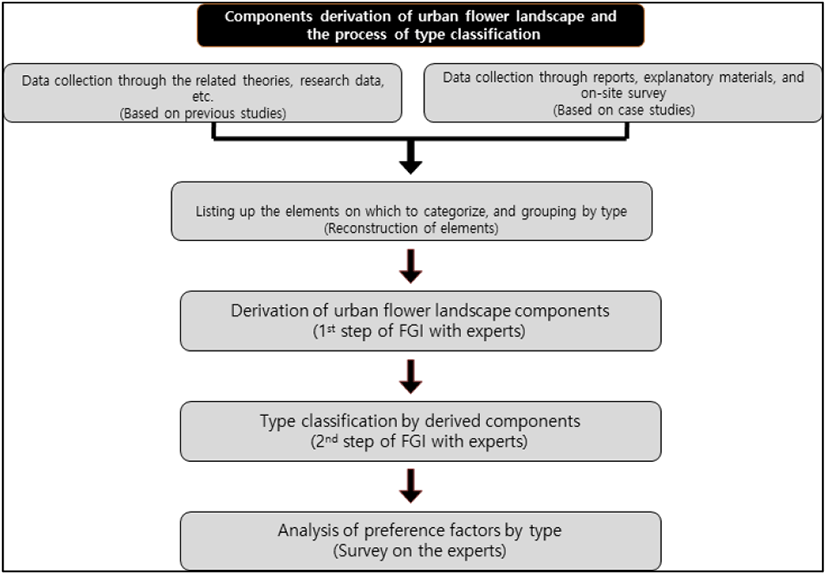
표적 집단 선정은 화훼 관련 조경설계 및 계획 분야, 화훼, 정원 관련 연구자, 화훼 전문 시공 분야, 공사감독(발주처) 분야 등 화훼 조경실무 전문가를 중심으로 구성하였다.
해당분야 경력은 최소 8년 이상에서 최고 33년으로 실무에 대한 업무 파악이 가능한 범위로 설정하였고, 학위는 석사학위 이상을 가진 사람을 대상으로 하여 실무와 이론을 겸비할 수 있는 전문가를 선정하였다. FGI를 위한 자료는 앞서 설명한 바와 같이 구축한 자료를 제공하였고(Table 2 참조), 전문가 FGI는 2020년 6월 7일~17일까지 1단계, 2020년 6월 19일~30일까지 2단계로 두 번에 걸쳐 실시하였다(Table 3 참조). 코로나19라는 세계적 팬더믹 상황을 반영하여 방문인터뷰, 이메일을 통한 서면 인터뷰 방식으로 진행하였으며 답변에 대한 추가 질문은 전화와 이메일을 통해서 진행하였다. 유형의 최종 합의 방법은 FGI 참석자들의 단일합의에 의한 판단을 기준으로 하였다. 14명의 전문가를 구성하여 도시 화훼경관에 적용 가능한 화훼경관 유형의 분류 요소 도출과 요소를 기준으로 유형화를 전개하였다(Table 4 참조). 요소 도출을 위한 최종 합의 방식은 앞서 3장에서 설명하였듯이 FGI 대상자들의 단일합의에 의한 판단을 기준으로 하였다. 전문가 FGI는 2020년 6월 7일~17일까지 1단계, 2020년 6월 19일~30일까지 2단계로 두 번에 걸쳐 실시하였다.
Ⅳ. 도시 화훼경관 유형화
전문가 FGI 가이드라인에서 제시되었던 선행 연구자료에 대해서는 전문가들의 의견을 반영하였고, 도시 화훼경관 유형화 요소 도출을 위해서는 기존의 선행연구는 물론 범위를 확장하여 화훼장식, 화예 디자인, 정원 식재, 비오톱, 도시경관, 도시계획, 토지이용 등 다양한 인접 분야까지 넓혀 진행하였다. 또 연관된 유형화 요소 도출을 위해 학위논문, 학술지, 연구보고, 단행본, 정책 지침, 법규자료 등을 고르게 배분하여 어느 한 부문에 편중되지 않도록 하였으며, 국내와 해외자료, 그리고 석사학위 논문과 박사학위 논문을 안배하여 총 40편의 연구자료에서 화훼경관 유형화 요소를 도출하고자 하였다.
추출된 요소들은 Park(2004), Jun(2009), Kang(2011), Kim (2012), Cho(2012), Jung(2013), Pi(2015), Shin(2018), Park (2019), Yoon and Kim(2019) 등 기존 관련 연구고찰을 통해 총 41개의 요소가 추출되었다(Table 5 참조).
| Division | Researchers | Title | Key-words for the type classification elements |
|---|---|---|---|
| Thesis | Cho, Y. Y. (2012) | Effect of Installing Flower Sculpture for Space Decoration | Nature, Space, Environment, Formativeness, Time |
| Hong, I. K. (2007) | A Study of Portfolio Design Regarding the Characteristics of Floral Art Works | Kind, Purpose, Form, Material | |
| Jang. Y. S. (2007) | Influential Factors of FAD·D upon Spatial Environment | Form, Technique, Material, Kind, Image, Elements, Composition, Size | |
| Kim. H. J. (2007) | A Study on Directing Floral Design by Perspective Trait | Form, Size, Placement, Location, Perspective Trait, Purpose | |
| Lee, H. K. (2008) | Visual Valuation of Indoor Plants and Typological Classification to Indoor Garden by Interior Design Style | Space, Form, Finishing, Purpose | |
| Kim, Y. J. (2012) | Study on the Image Characteristics and Evalution Criteria of Public Floral Design | Surrounding environment, Color, Form, Scale, Material for Use | |
| Kang, H. K. (2011) | A Comparative Study of Korean and Japaness Floral Design Trends | Form, Color, Material, Object | |
| Kim, O. K. (2008) | A Study of the Outdoor Floral Sculptures for the Improvement of the Urban Landscape | Form, Size | |
| Yoon. D. K. (2016) | Analysis of Landscape Images and Preferences to the Urban Flower Decorations | Form | |
| Ham, E. J. (2020) | Analysis of Flowerscape Typology Images and Preferences for the Arboretum | Decoration, Form, Vegetation, Line | |
| Shin, K. S. (2018) | A Study on the Space Typology of Three-dimensional Greenery System of Buildings for Environment Friendly Space Composition | Location, Form | |
| Pi, J. H. (2015) | Coastal Dune Typology and Management Plan by Ecological Structure Analysis | Vegetation, Use(purpose), Structure | |
| Kim, H. S. (2011) | Classification Biotope Type and Evaluation Value of Individual Biotope: Landscape Ecological Approaches | Land-use(place), Vegetation, Repair | |
| Jung, E. J. (2013) | A Study on the Effects and Role of Environmental Sculptures in Urban Space | Content, Purpose, Placement, Form, Material, Technique, Skill | |
| Shin, Y. N. (2015) | A Study of the Open Space Typology and Multi-functionality for the Effective Management of the Green Space Resources | Land-use, Location Form | |
| Park, T. H. (2004) | A Study of the Visual Impacts of Environmental Sculptures | Color, Material, Size, Location, Form | |
| Won, H. Y. (2018) | Typology and Evolutionary Characteristics of Design Diversification | Concept, Form, Object, Function, Convergence, Single | |
| Journal | Yoon, D. K. and Kim, K. W. (2019) | Preference Analysis of Urban Flower Decorations by Type | Form |
| Hwang, J. H. (2003) | Characteristics of Urban Landscape Type in Cheongju | Land-use, Visual Characteristics | |
| Kim, D. H. et al. (2005) | The Classification and Characteristics of Landscape on Urban Land Use Patterns | Land-use, Visual Characteristics | |
| Park, M. O. (2019) | A Study on the Reference Models for Wetland Gardens Based on the Village Wetlands | Topography(Form), Vegetation, Water circulation system(Form) | |
| Bang, J. S. and Yang, B. E. (2009) | A Study on the Classification Criteria of Landscape Type for Urban Landscape Planning | Land-use(place) Location Form | |
| Suh, J. H. et al. (2008) | A Study on the Analysis of Visual Preference and Image for the Display Type of Outdoor Floral Sculpture | Form, Color | |
| Makin(2019) | Symmetry Preference in Shapes, Faces, Flowers and Landscapes | Preference, Form, Image, Symmetry | |
| Shim, E. J. (2010) | A Study on Users’ Spatial Images and Perceptions of Gwanghwamun Plaza | Activities(purpose) | |
| An, H. E. and Kim, S. W. (2013) | A Study on the Flower Decorations for Improvement of Urban Public Spaces | Placement Space, Purpose of Use, Form | |
| Research reports | Son, K. H. (2015) | Garden Industry Scope, Business Type and Activation Plan | Purpose of use, Place |
| Rapoport(1997) | Human Aspects of Urban Form | Form, Size, Material, Quality of Space, Artificial Nature | |
| Shin, J C. and Shin, J. H. (2003) | Design Guidelines for Urban Landscape Improvement | Width(spatial scope) | |
| Park, E. Y. (2020) | Concept of Gardening (A Lecture Material) | Color, Form, Texture, Time, Space | |
| Books | Son, K. H. (2004) | Floral and Plant Design for Beautiful Living Spaces | Form, Space, Depth, Color, Texture |
| Lim, S. B. (2014) | Landscape Analysis Theory, Seoul National University Press | Point, Line, Form, Size and location, Texture, Color, Joke, Variable | |
| Jones(2018) | The Garden Source | Formative, Material, Place, Generation | |
| Yoon, S. E. (2006) | Introduction to Flower Design | Naturality, Spaceness, Environmentality, Formativeness, Temporality | |
| Policy guidelines | Ministry of Land, Infrastructure, and Transport(2015) | The First Basic Plan for Landscape Policy (2015~2019) p. 37, 38 | Place, Form |
| Forest Service(2016) | The First Basic Plan for Garden Promotion (2016) | Local Characteristics, Creating Space, Creation Purpose, Creation Form | |
| Forest Service(2009) | The Second Basic Plan for Arboretum Promotion (2009~2013) p. 33 | Color, Form, Size | |
| Seoul Development Institute(1993) | Seoul City Landscape Management Plan | Municipal Administration, Width(scale), Personality | |
| Act | Ministry of Land, Infrastructure, and Transport (2020) | City Park and Green Land Act Article 15 (Subdivision and Scale of City Park) | Purpose(agent), Function |
| Forest Service(2015) | Arboretum Creation and Promotion Act Article 4 (Division of Arboretum and Garden) | Operating Agent | |
| Extracted urban flower landscape type classification elements | |||
| form/ decoration method/ line/ formative/ point/ technique/ space/ place/ environmentality/ location/ placement/ scale/ size/ material/ naturality/ finishing/ time/ vegetation/ color/ texture/ visual characteristics/ joke / content/ purpose/ concept/ purpose of use/ structural/ objectified/ depth/ convergence/ variable/ kind/ repair/ function/ object/ image/ preference/ symmetry/ timing/ theme/ composition (41) | |||
선행연구 자료와 전문가 FGI 결과를 반영한 군집화에 의해 도출된 유형 요소들의 빈도분석을 한 결과, ‘형태’에 속하는 요소의 빈도는 36회, ‘장소’와 관련된 요소의 빈도는 40회, ‘재료’와 관련된 요소의 빈도는 33회, ‘용도’ 관련된 요소의 빈도는 14회 나머지 기타 15개 항목에 걸쳐서 각각 1~2회 정도의 빈도가 확인되었다(Table 6 참조).
군집화의 기준은 군집의 성격 및 내용의 유사성에 따라 1차로 연구자가 분류한 후 전문가 FGI를 통해 수정 보완 과정을 거쳤으며, 군집을 대표하는 통합적인 네이밍은 빈도수가 많은 용어로 제시하였고 전문가 FGI에서도 모두 동의하였다(Table 7, Table 8 참조).
선행 연구의 빈도분석과 전문가 FGI 확인 과정을 통해 확정된 유형화 요소 즉, 유형의 최종 분류 기준은 형태(form)·장소(place)·재료(material)·용도(purpose)의 4개 요소이며, 정리하면 Table 9와 같다.
| Urban flower landscape type classification elements | |||
|---|---|---|---|
| 형태(Form) | 장소(Place) | 재료(Material) | 용도(Purpose) |
2차 전문가 FGI는 2020년 6월 19일~27일까지 실시하였다. 방식은 1차와 같은 방식으로 2020년 코로나 19라는 국제적 팬데믹 상황이라는 특수한 여건으로 인해 이메일을 통한 인터뷰 및 방문, 전화통화 방식을 병행하여 진행했다. 2차는 FGI 1차에서 유형화와 관련하여 구체적인 코멘트나 방향을 제시한 6명의 전문가로 압축해 진행되었다.
Kim(2007), Jang(2007), Hong(2007), Lee(2008), Kim(2011), Kim(2012) 등 다수의 연구에서 유형 관련 연관 요소 중의 하나로 ‘형태’가 언급되거나 제시되고 있다. 분류의 기준과 관련해서 FGI 의견은 형태는 형(形), 즉 shape로 보아야 하며 공간 형태에 의한 분류 즉, 2차원/3차원의 관계로 접근해야 하는 것에 일부 이견도 있었지만 대체로 합의하였고, 유형화 내용과 관련한 FGI 의견 쟁점은 색상이나 질감을 어떻게 보는가였다. 화훼는 특성상 색상이나 질감 자체가 화훼의 생리적 특성이므로 형태보다는 소재로 분류되는 것이 바람직하다는 의견으로 합의되었다.
선행연구와 전문가 FGI를 바탕으로 한 유형 정리는 현재 도시 화훼경관에 적용될 수 있는 중분류 유형을 평면형과 입체형으로 분류되고, 다시 평면형은 소분류로 점형, 선형, 면형으로 분류되고 입체형은 소분류로 수직 벽면형, 컨테이너형, 오브제 활용형, 화훼조형물형으로 분류하였다(Table 10, Table 11, Table 12 참조).
| Classification criteria | Middle-classification | Small-classification |
|---|---|---|
| Form | Plane | Point type |
| Line type | ||
| Plane type | ||
| Solid | Vertical wall type | |
| Container type | ||
| Object type | ||
| Flower sculpture type |
Hwang(2003), Park(2004), Kim(2007), Kim(2011), Cho(2012), Shin(2015) 등 다수의 선행연구에서 유형 관련 연관 요소 중의 하나로 ‘장소’가 언급되거나 제시되고 있다. 분류의 기준과 관련해서 FGI 의견 쟁점은 장소는 유형화 요소로서 부적합하다는 의견이 있었지만, 앞선 선행연구에서 유형화 요소로서 ‘장소’가 40회의 빈도수를 보이면서 유형화 4개 요소 중 중요한 요소로서 위상을 갖고 있다라는 결과와 FGI에서 다른 전문가들이 이견이 없었다.
선행연구와 전문가 FGI를 바탕으로 한 유형 정리는 도시 화훼경관 ‘장소’ 요소에 따른 유형화는 중분류 ‘건축물형’과 ‘오픈스페이스형’으로 분류하고 ‘건축물형’은 다시 소분류로 주거지형, 상업지형, 공공 및 업무지형, 중분류 ‘오픈스페이스형’은 소분류로 광장형, 가로형, 연결 시설지형, 테마지형, 공원녹지지형으로 분류하였다(Table 13, Table 14, Table 15 참조).
Rapoport(1997), Park(2004), Jang(2007), Kim(2007), Kang (2011), Kim(2011), Kim(2012) 등 다수의 선행연구에서 유형 관련 연관 요소 중의 하나로 ‘재료’가 언급되거나 제시되고 있다.
유형화 내용과 관련해서 FGI 의견은 소재에서 화훼를 초화류로 한정 짓고, 화관목은 제외하는 것이 체계적일 것 같다는 의견에 대해서도 화훼경관의 유형화 작업이 최초라는 점을 감안하여 분류 체계상 목본류도 화훼경관의 범위이기 때문에 분류체계 내에서 수용해야 하고, 화관목뿐만 아니라 목본류로 바꾸어 재료의 확장성을 감안한 분류체계로 정리하였다.
선행연구와 전문가 FGI를 바탕으로 한 유형 정리는 전문가 FGI를 통해 수정된 도시 화훼경관 ‘재료’ 요소에 따른 유형화는 중분류는 ‘초본형’, ‘혼합형’, ‘목본형’으로 분류하고, 중분류 ‘초본형’은 소분류 초본 색상형, 초본 질감형, 초본 형태미형, 중분류 ‘혼합형’은 소분류 혼식 색상형, 혼식 질감형, 혼식 형태미형으로 중분류 ‘목본형’은 소분류 목본 색상형, 목본 질감형, 목본 형태미형으로 분류하였다(Table 16, Table 17, Table 18 참조).
Kim(2007), Hong(2007), Lee(2008), Shim(2010), An and Kim(2013), Jung(2013), Son(2015), Pi(2015) 등 다수의 선행연구에서 유형 관련 연관 요소 중의 하나로 ‘용도’가 언급되거나 제시되고 있다. 분류의 기준과 관련해서 FGI쟁점으로 비물리적 요소인 ‘용도성’은 ‘장소’와도 상당히 밀접한 인과관계가 있다고 보며, 따라서 장소 내에 비물리적 요소인 용도성이 어느 정도 의미를 내포하고 있는 것 같으므로 두 가지를 합치거나 ‘장소’의 내용에 ‘용도’을 포함하는 방안도 검토가 필요하다는 의견을 개진하였다. 많은 선행연구에서 ‘용도’는 독립적 분류 항목으로써의 지위를 빈도수 측면에서 부여받고 있어 별도 유형 항목으로 분류했다.
선행연구와 전문가 FGI를 바탕으로 한 유형 정리 도시 화훼경관 ‘용도’ 요소에 따른 유형화는 중분류는 ‘감상형’과 ‘활동형’으로 중분류하였고, ‘감상형’은 소분류로 관상형, 전시형, 관광형으로, ‘활동형’은 소분류로 체험형, 치유형, 생산형으로 분류하였다(Table 19, Table 20, Table 21 참조).
| Classification criteria | Middle-classification | Small-classification |
|---|---|---|
| Purpose | Appreciation type | Viewing type |
| Exhibition type | ||
| Tourism type | ||
| Activity type | Experience type | |
| Healing type | ||
| Producing type |
앞서 각 관련 분야별 지침과 정책자료, 선행연구 등의 고찰을 통해 도출된 형태(form)·장소(place)·재료(material)·용도(purpose) 4개의 주요 유형화 요소를 분류의 기준으로 삼아 선행 이론고찰과 전문가 FGI 과정을 통하여 도시 화훼경관 유형화 과정을 중분류, 소분류로 심도 있게 진행하였다. 도시 화훼경관 유형화를 위한 1차 분류기준을 도출하기 위하여 선행연구에서 종합한 내용으로 전문가 표적 집단 면접(Focus Group Interview: FGI)을 실시하였으며, 1차 총 14명, 2차 6명의 전문가를 구성하였다. 도시 화훼경관에 적용 가능한 화훼경관 유형의 분류 요소 도출과 그 요소를 기준으로 유형화를 전개하였고, 중분류 9개, 소분류 30개를 도출하였다(Table 22 참조).
우리나라 대표도시, 광화문광장과 서울광장을 축으로 세종로 정부 청사, 서울시청, 공공 및 업무지와 상가, 주택이 어우러져 다양한 얼굴로 다양한 공간의 성격을 가지고 있다. 서울정원박람회의 매년 개최를 통한 정원 붐 조성, 각 자치구의 꽃도심 만들기 사업 등, 화훼경관의 관심과 도입이 확대되는 추세이며, 선행연구에서 도출한 24개 화훼경관 유형을 설치 사례지 방문을 통해 확인할 수 있었다(Figure 4 참조).
런던은 시대적, 환경적 여건에 의해 일찍부터 정원문화가 발전한 정원 선진국이다. 따라서 런던 도심의 일상에서 화훼는 친숙한 도시 활동의 구성요소이자 도시의 얼굴이다. 공원, 가로, 상업지, 업무지, 주택가를 망라하고 다양한 유형의 꽃장식물과 도시 화훼경관을 쉽게 볼 수 있다. 4계절 플라워 쇼가 있고, 정원 생활은 런던 시민들의 일상이다. 런던의 정원연출기법은 국내에도 많이 유입되고 있는 추세이며, 선행연구에서 도출한 24개 화훼경관 유형을 설치 사례지 방문을 통해 확인할 수 있었다(Figure 5 참조).
싱가포르는 정원 도시라고 한다. 현대적인 건축물의 집합장처럼 보이지만 싱가포르의 도시는 끊임없는 녹지 축의 연결이다. 녹지축에 둘러쌓인 도심은 그린인프라 기반 위에서 녹색의 생명 경관이 작동하는 방식으로 회색의 도시가 아닌 녹색으로서 향후 세계 모든 도시 발달의 모델이 되는 곳이기도 하다. 또한, 싱가포르는 꽃과 식물을 Show적 연출을 통해 세계적 관광 상품으로 만들어낸 우수한 화훼경관 운영 모델을 갖고 있는 곳이다. 선행연구에서 도출한 24개 화훼경관 유형을 설치 사례지 방문을 통해 확인할 수 있었다(Figure 6 참조).
도시 화훼경관 유형이 적용된 서울, 런던, 싱가포르시, 도시 사례 3개를 살펴보았다. 선행 연구의 유형화 과정에서 분류의 준거가 되는 장소, 형태, 재료, 용도에 의해 유형화된 화훼경관 30개 유형이 3개 사례 도시에 일반적으로 적용되고 있음을 알 수 있었다. 기후와 문화, 역사, 삶의 환경은 형식적인 측면에서 모두 차이가 있지만, 도시라는 속성, 또 그 도시에서 살아가는 사람들의 미적, 생태적 지향이 다르지 않고, 또한 도시 계획상의 토지이용 관점이 유사하기 때문에 도시경관에서 그리고 화훼경관에서 공통점이 나타난 것으로 보인다(Table 23 참조).
앞서 선행연구들과 법규 및 정책, 지침 등의 검토로 정리된 화훼경관 유형과 국내 및 해외 사례 연구에서 도출된 도시 화훼경관 유형을 종합하면 Table 24와 같이 형태, 장소, 재료, 용도로 분류할 수 있었다. 선행연구에서 도출된 주요 30개 유형은 사례연구에서도 거의 일치된 형태로 방문 확인할 수 있었다. 따라서 본 연구에서 정리된 도시 화훼경관 유형은 보편적이고 타당한 분류가 되었음을 확인하였다(Table 24 참조).
이렇게 분류된 유형을 매트릭스 조합 방식에 의거하여 유형 모델 48개를 도출하였다. 유형 모델을 도출하는데 있어 핵심 사항은 유형 분류코드를 만들었는데 대분류인 장소는(P), 형태(F), 재료(M)으로 하였고 각각 중분류 또는 소분류에서 P1(주거지형), P2(상업지형), …, F1(평면형), F2(입체형), … M1(초본형), M2(혼합형)… 등으로 각각 구분하였다. 요소 조합 과정에서 장소를 기준으로 하여 세로축에 놓고 가로축에는 형태, 재료 항목을 배치하였다. 그리고 형태, 재료는 중분류 유형을 조합항목으로 하였고, 장소는 소분류 항목을 조합항목으로 하였는데, 이는 도시라는 공간에서 장소적 특성을 보다 세분화된 단위까지 반영한 유형 모델을 도출해야 본 연구의 목적 중 하나인 다양한 도시 공간에 적용 가능한 화훼경관 유형을 도출하여 수요자의 합리적인 선택기준 제공을 달성할 수 있기 때문이다. 형태, 장소, 재료의 경우처럼 물리적인 유형과 용도의 경우처럼 비물리적인 유형이 있는데, 유형 모델을 도출하는 과정에서는 물리적 형상이나 물리적 특성을 조합하여 유형 모델을 도출하는 것이므로 비물리적인 유형인 용도는 조합항목에서 제외하였다(Table 25 참조).
유형의 매트릭스 조합을 통해 8개 장소에 대한 각각 6개 모델로 총 48개의 유형 모델을 1차로 도출한 후 각 장소에서 평면-혼합형, 평면-혼합형은 실제로 성립할 수 없는 모델이다. 왜냐하면, 혼합형은 초본과 목본의 혼합인데 평면일 수가 없고, 목본형도 그 자체가 입체적 형태이기 때문에 평면-목본형은 성립되지 않는다. 각 장소별 유형 모델에서 성립되지 않는 모델을 제외하여 총 32개의 유형 모델을 도출하였다. 대분류 장소(P)는 소분류 P1(주거지형), P2(상업지형), P3(Plaza형), P4(광장형), P5(Connection facility area형), P6(연결시설지형), P7(테마지형), P8(공원녹지지형), F1(평면형), F2(입체형)으로 분류하였고, 대분류 형태(F)는 F1(평면형), F2(입체형)으로 구분하고 대분류 재료(M)는 M1(초본형), M2(혼합형), M3(목본형)으로 분류하였다. 분류 및 적용 편의를 위해 유형 분류코드는 각 분류키에 따라 ‘PnFnMn’ 형태로 구성하였다. Pn은 장소 입지코드(P1, P2, P3, …, P8), Fn은 형태코드(F1, F2), Mn은 재료코드(M1, M2, M3)를 의미한다. 분류코드는 대상지 유형별 현장 조사 때 활용된다. 유형 모델은 향후 선호도 조사를 통해 수요자들의 합리적인 선택에 유효한 기초자료가 될 것이다(Table 26 참조).
Ⅴ. 결론
본 연구의 최초 목적은 첫째, 화훼경관 개념의 재구성을 통해 통합 이론의 기초자료 제공, 둘째, 화훼경관이 도시경관의 한 장르로 그리고 도시경관의 단위로 왜 정의되고 연구할 필요가 있는지를 밝혀 전문영역으로서 체계 구축, 셋째, 도시 화훼경관 유형화를 통한 수요자들의 합리적이고 효율적인 화훼경관 유형의 선택자료를 제시하기 위함이었다. 이러한 연구목표를 달성하기 위해 연구를 수행한 결과는 다음과 같다. 첫째, 문헌과 사례를 통하여 그간에 도입된 화훼경관 또는 화훼장식과 관련된 무수한 개념과 용어들의 특성과 한계를 분석하였다. 화훼경관의 개념이 정리되기 위해서는 개념의 핵심 어휘와 문장에 공간적 요소, 형태적 요소, 자연적 요소, 인공적 요소라는 4가지 요소가 담겨야함을 선행연구를 통해 발견하였으며 이 네 가지 요소로 화훼경관 개념을 새롭게 재구성하였다.
둘째, 화훼경관이 도시경관의 한 장르로 그리고 도시경관의 단위로 왜 정의되고 연구할 필요가 있는지를 밝혀 전문영역으로써 체계 구축 부분은 도시경관이라는 커다란 범주 안에서 도시경관의 개념과 특성, 기능을 고찰하고, 그 안에서 화훼경관과의 위계화 범주를 새롭게 정리하여 제시하였다. 이는 화훼경관의 계통성을 정리한 것으로 전문영역으로서의 체계 구축을 시도한 것이고 화훼경관의 도시경관성을 더 보완하는 이론이 될 것이며, 화훼경관의 새로운 역할에 대한 제안이 될 것이다.
셋째, 유형화를 통한 수요자들의 합리적인 선택자료 제시에서 유형화 작업은 유형화를 위하여 화훼분야는 물론, 도시계획, 도시 생태 분야의 정책 지침, 법률자료까지 확장하여 관련 이론을 고찰하였으며, 유형화 요소 41개를 추출하였고, 군집화 과정을 통해 형태, 장소, 재료, 용도라는 4개의 핵심 유형화 요소를 도출하였다. 4개의 요소를 분류 준거로 하여 선행이론과 국내 및 해외 사례 조사를 통해 가이드라인을 도출하고, 두 차례 진행된 전문가 FGI에서 의견과 검증의 과정을 거쳤고, 중분류 9개, 소분류 30개 유형을 도출하여 제시하였다. 그리고 장소, 형태, 재료 유형의 조합을 통해 유형모델 32가지를 도출하여 수요자들의 합리적인 선택에 유효한 자료로 제공될 것이다.
연구의 한계점으로는 화훼경관 개념에 관한 연구는 화훼관련 선행 연구의 대다수가 실내 화훼장식물로서 공간 배치 특성이 실내로 한정되고, 옥외 도시경관적 차원의 규정과 개념이 미흡하다 보니 유형화 과정에서 과거 연구로부터의 계통성 확보가 어려운 부분이 있었고, 전문가 FGI를 통한 확인과 검증과정이 있었다고 하더라도 계속적인 추가 연구가 필요하다고 본다. 유형화의 위계도 중분류와 소분류 2단계로 진행했다. 이는 어떤 한 분야에서 최초 유형화 작업 시 일반적으로 선택하는 방식이며, 향후 유형 적용단계에서 가변성을 감안한 것이다. 향후 연구는 적용과정에서의 모니터링을 통해 유효한 유형의 추가 설정과 2단계 분류 위계를 3단계 위계로 확장하여, 보다 세분화된 적용 유형의 개발과 정리를 한다면 유형의 체계를 보다 발전시키는 좋은 연구가 될 것으로 보인다.

